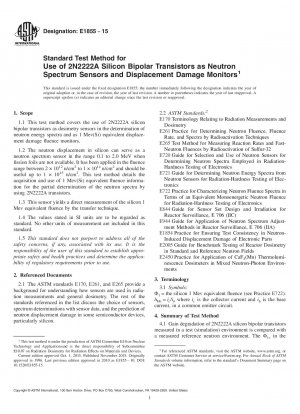ASTM E1855-15
Standard Test Method for Use of 2N2222A Silicon Bipolar Transistors as Neutron Spectrum Sensors and Displacement Damage Monitors
- Standard No.
- ASTM E1855-15
- Release Date
- 2015
- Published By
- American Society for Testing and Materials (ASTM)
- Status
- Replace By
- ASTM E1855-20
- Latest
- ASTM E1855-20
- Scope
5.1 The neutron test spectrum must be known in order to use a measured device response to predict the device performance in an operational environment (E1854). Typically, neutron spectra are determined by use of a set of sensors with response functions sensitive over the neutron energy region to which the device under test (DUT) responds (E721). For silicon bipolar devices exposed in reactor neutron spectra, this effective energy range is between 0.01 and 10 MeV. A typical set of activation reactions that lack fission reactions from nuclides such as 8201;235U, 8201;237Np, or 8201;239Pu, will have very poor sensitivity to the spectrum between 0.01 and 2 MeV. For a pool-type reactor spectrum, 70 % of the DUT electronic damage response may lie in this range.
5.2 When dosimeters with a significant response in the 10 keV to 2 MeV energy region, such as fission foils, are unavailable, silicon transistors may provide a dosimeter with the needed response to define the spectrum in this critical energy range. When fission foils are part of the sensor set, the silicon sensor provides confirmation of the spectral shape in this energy region.
5.3 Silicon bipolar transistors, such as type 2N2222A, are inexpensive, smaller than fission foils contained in a boron ball, and sensitive to a part of the neutron spectrum important to the damage of modern silicon electronics. They also can be used directly in arrays to map 1 Mev(Si) equivalent displacement damage fluence. The proper set of steps to take in reading the transistor-gain degradation is described in this test method.
5.4 The energy-dependence of the displacement damage function for silicon is found in E722. The major portion of the response for the silicon transistors will generally be above 100 keV.
1.1 This test method covers the use of 2N2222A silicon bipolar transistors as dosimetry sensors in the determination of neutron energy spectra and as 1 Mev(Si) equivalent displacement damage fluence monitors.
1.2 The neutron displacement in silicon can serve as a neutron spectrum sensor in the range 0.1 to 2.0 MeV when fission foils are not available. It has been applied in the fluence range between 2 × 1012 n/cm 2 to 1 × 1014 n/cm2 and should be useful up to 1 × 1015 n/cm2. This test method details the acquisition and use of 1 Mev(Si) equivalent fluence information for the partial determination of the neutron spectra by using 2N2222A transistors.
1.3 This sensor yields a direct measurement of the silicon 1 Mev equivalent fluence by the transfer technique.
1.4 The values stated in SI units are to be regarded as standard. No other units of measurement are included in this standard.
1.5 This standard does not purport to address all of the safety concerns, if any, associated with its use. It is the responsibility of the user of this standard to establish appropriate sa......
ASTM E1855-15 Referenced Document
- ASTM E170 Standard Terminology Relating to Radiation Measurements and Dosimetry
- ASTM E1854 Standard Practice for Ensuring Test Consistency in Neutron-Induced Displacement Damage of Electronic Parts
- ASTM E2005 Standard Guide for Benchmark Testing of Reactor Dosimetry in Standard and Reference Neutron Fields
- ASTM E2450 Standard Practice for Application of CaF
2 (Mn) Thermoluminescence Dosimeters in Mixed Neutron-Photon Environments - ASTM E261 Standard Practice for Determining Neutron Fluence, Fluence Rate, and Spectra by Radioactivation Techniques
- ASTM E265 Standard Test Method for Measuring Reaction Rates and Fast-Neutron Fluences by Radioactivation of Sulfur-32
- ASTM E720 Standard Guide for Selection and Use of Neutron-Activation Foils for Determining Neutron Spectra Employed in Radiation-Hardness Testing of Electronics
- ASTM E721 Standard Guide for Determining Neutron Energy Spectra from Neutron Sensors for Radiation-Hardness Testing of Electronics
- ASTM E722 Standard Practice for Characterizing Neutron Energy Fluence Spectra in Terms of an Equivalent Monoenergetic Neutron Fluence for Radiation-Hardness Testing of Electronics
- ASTM E844 Standard Guide for Sensor Set Design and Irradiation for Reactor Surveillance, E 706(IIC)
- ASTM E944 Standard Guide for Application of Neutron Spectrum Adjustment Methods in Reactor Surveillance, (IIA)
ASTM E1855-15 history
- 2020 ASTM E1855-20 Standard Test Method for Use of 2N2222A Silicon Bipolar Transistors as Neutron Spectrum Sensors and Displacement Damage Monitors
- 2015 ASTM E1855-15 Standard Test Method for Use of 2N2222A Silicon Bipolar Transistors as Neutron Spectrum Sensors and Displacement Damage Monitors
- 2010 ASTM E1855-10 Standard Test Method for Use of 2N2222A Silicon Bipolar Transistors as Neutron Spectrum Sensors and Displacement Damage Monitors
- 2005 ASTM E1855-05e1 Standard Test Method for Use of 2N2222A Silicon Bipolar Transistors as Neutron Spectrum Sensors and Displacement Damage Monitors
- 2005 ASTM E1855-05 Standard Test Method for Use of 2N2222A Silicon Bipolar Transistors as Neutron Spectrum Sensors and Displacement Damage Monitors
- 2004 ASTM E1855-04e1 Standard Test Method for Use of 2N2222A Silicon Bipolar Transistors as Neutron Spectrum Sensors and Displacement Damage Monitors
- 2004 ASTM E1855-04 Standard Test Method for Use of 2N2222A Silicon Bipolar Transistors as Neutron Spectrum Sensors and Displacement Damage Monitors
- 1996 ASTM E1855-96 Standard Test Method for Use of 2N2222A Silicon Bipolar Transistors as Neutron Spectrum Sensors and Displacement Damage Monitors

Copyright ©2024 All Rights Reserved